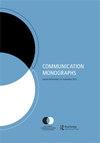谎言流行率的巨大变化:撒谎成性、糟糕的谎言日,还是两者兼而有之?
IF 3.1
2区 文学
Q1 COMMUNICATION
引用次数: 14
摘要
摘要检验真理默认理论,通过检查632名参与者在91天内说出的116366个谎言,从个人日常变化(好/坏谎言天数)中解析出谎言频率的个人水平变化。正如预测的和先前的发现一致,分布是正偏的。大多数参与者很少撒谎,大多数谎言都是由一些多产的骗子说的。大约四分之三的参与者都是一贯的低频说谎者。在参与者中,撒谎占总交流的7%,几乎90%的谎言都是善意的小谎言。约58%的方差由稳定的个体差异解释,约42%的方差归因于人内日常变异性。这些数据既符合少数撒谎成性的人的存在,也符合撒谎的好日子/坏日子。本文章由计算机程序翻译,如有差异,请以英文原文为准。
Unpacking variation in lie prevalence: Prolific liars, bad lie days, or both?
ABSTRACT Testing truth-default theory, individual-level variation in lie frequency was parsed from within-individual day-to-day variation (good/bad lie days) by examining 116,366 lies told by 632 participants over 91 days. As predicted and consistent with prior findings, the distribution was positively skewed. Most participants lied infrequently and most lies were told by a few prolific liars. Approximately three-quarters of participants were consistently low-frequency liars. Across participants, lying comprised 7% of total communication and almost 90% of all lies were little white lies. About 58% of the variance was explained by stable individual differences with approximately 42% of the variance attributable to within-person day-to-day variability. The data were consistent with both the existence of a few prolific liars and good/bad lie days.
求助全文
通过发布文献求助,成功后即可免费获取论文全文。
去求助
来源期刊

Communication Monographs
COMMUNICATION-
CiteScore
5.40
自引率
0.00%
发文量
12
期刊介绍:
Communication Monographs, published in March, June, September & December, reports original, theoretically grounded research dealing with human symbolic exchange across the broad spectrum of interpersonal, group, organizational, cultural and mediated contexts in which such activities occur. The scholarship reflects diverse modes of inquiry and methodologies that bear on the ways in which communication is shaped and functions in human interaction. The journal endeavours to publish the highest quality communication social science manuscripts that are grounded theoretically. The manuscripts aim to expand, qualify or integrate existing theory or additionally advance new theory. The journal is not restricted to particular theoretical or methodological perspectives.
 求助内容:
求助内容: 应助结果提醒方式:
应助结果提醒方式:


